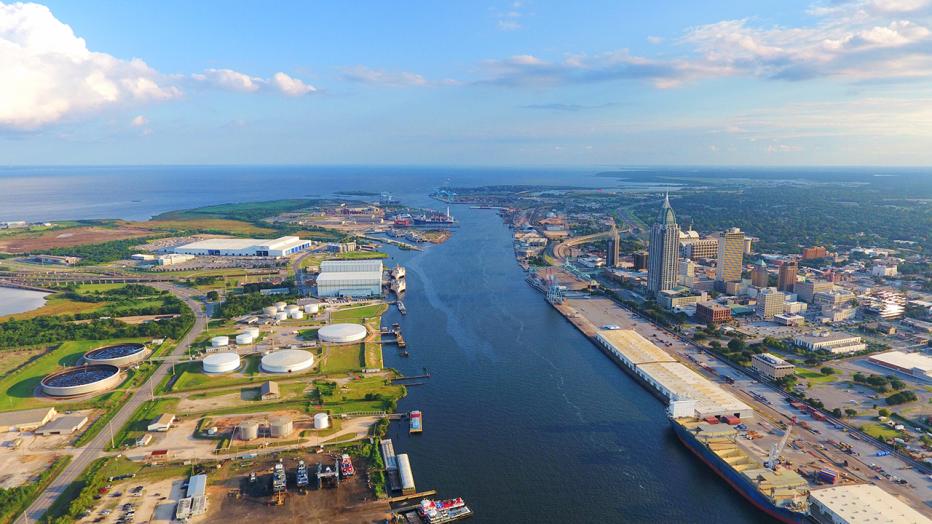
Long known as the cultural center of the U.S. Gulf Coast, the 300-year-old port city of Mobile, Alabama, is home to approximately 200,000 residents. To serve this area, the Mobile Area Water and Sewer System (MAWSS) operates and maintains two centralized wastewater treatment plants, with 40.8 mgd permitted capacity, two water treatment plants, with 90 mgd permitted capacity, more than 200 lift stations and over 2,800 miles combined of water and sewer pipelines, 40% of which are over 50 years old.
Mobile is in a flat coastal plain, situated along the western shore of Mobile Bay, where the 44,000-square mile Mobile River basin drains into the Gulf of Mexico. Compounding these geographic issues, Mobile is among the rainiest cities in America, receiving more than 65 inches of precipitation annually.
Facing the daunting task of assessing the condition of its system and determining the most appropriate expenditure of funds in the most critical areas of their system, MAWSS turned to Jacobs. Working together as a team for approximately 18 months, we developed and incorporate a risked-based approach to prioritize capital expenditures and develop a fiscal policy to implement its 15-year water and sewer master plan to progress toward its mission of becoming a model utility. The scope included:
- Thorough condition assessments of raw water facilities; water treatment plants; water distribution system; sewer collection and transmission systems; severe weather attenuation facilities; raw water storage reservoirs/impoundments; and wastewater treatment plants.
- Facility assessment focused on structural, electrical, mechanical, controls, site-civil, architectural, geotechnical, physical security and cyber-security.
- Assessment of source water protection and secondary raw water supply.
- Assessment and evaluation of operations and maintenance processes such as SCADA, GIS and CMMS to determine the best and most cost effective uses of these processes.
- Development of business case evaluations (BCEs) to compare various alternatives for solids handing, wholesale customer services and providing wastewater services to remote area.
- Local stakeholder involvement in growth and development projects.
- Asset management modeling to score and prioritize capital improvement projects.
Jacobs developed condition assessment data and performance metrics using an iterative approach – which included collaborating with MAWSS staff and performing detailed investigations – and then incorporated these results into an asset management model to evaluate the likelihood and consequence of failure on system performance and reliability. We also developed cost estimates for each identified project totaling more than $1.1 billion in project needs that were further prioritized to address the most critical challenges facing MAWSS over the next 15-years; challenges also facing most other utilities throughout Alabama and Mississippi: infrastructure age, geography, climate and limited financial resources.
As MAWSS embarks on implementation of the System Master Plan, Jacobs will continue to support the delivery of key projects and continue our partnership with MAWSS as it seeks to continue its trek towards becoming a model utility.
Want to know more about our work on the MAWSS System Master Plan, and other exciting and innovated ways we’re meeting the needs of our clients and their customers throughout Alabama and Mississippi? Join us at AL/MS WaterJam in Mobile, Alabama, July 28 -31 as our team of industry-leading experts share:
- “Risk-Based Prioritization of the MAWSS System Master Plan” at 10:00 AM on Monday, July 29 [Jacobs’ Daniel Broxson and David Stejskal].
- “Assessment, Alternative Review and use of Dynamic Hydraulic Modeling in Development of the Best Long-Term Solution” on Monday, July 29 at 1:00 PM [Mobile Area Water and Sewer System’s Doug Cote and Jacobs’ Mike Stickley, Michelle Mayes and David Stejskal].
- “Pitfalls in Security- Why it Happened and How to Fix it” at 3:30 PM on Monday, July 29 [Jacobs’ Bob Craig].
- “A Collaborative Adaptive Management Approach to TMDL Development and Implementation” with Jefferson County Alabama Environmental Services District on Tuesday, July 30 at 11:00 AM [Jefferson County’s David Denard, Jacobs’ J.P. Martin and Lynn Sisk].
- “Developing the Workforce of the Future” on Wednesday, July 31 alongside Jefferson County Alabama Environmental Services Department at 10:00 AM [Jefferson County’s Margaret Tanner, Jacobs’ Lynn Phillips].












































